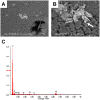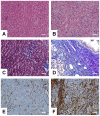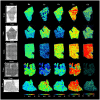Novel bioimaging techniques of metals by laser ablation inductively coupled plasma mass spectrometry for diagnosis of fibrotic and cirrhotic liver disorders
- PMID: 23505552
- PMCID: PMC3591358
- DOI: 10.1371/journal.pone.0058702
Novel bioimaging techniques of metals by laser ablation inductively coupled plasma mass spectrometry for diagnosis of fibrotic and cirrhotic liver disorders
Abstract
Background and aims: Hereditary disorders associated with metal overload or unwanted toxic accumulation of heavy metals can lead to morbidity and mortality. Patients with hereditary hemochromatosis or Wilson disease for example may develop severe hepatic pathology including fibrosis, cirrhosis or hepatocellular carcinoma. While relevant disease genes are identified and genetic testing is applicable, liver biopsy in combination with metal detecting techniques such as energy-dispersive X-ray spectroscopy (EDX) is still applied for accurate diagnosis of metals. Vice versa, several metals are needed in trace amounts for carrying out vital functions and their deficiency due to rapid growth, pregnancy, excessive blood loss, and insufficient nutritional or digestive uptake results in organic and systemic shortcomings. Established in situ techniques, such as EDX-ray spectroscopy, are not sensitive enough to analyze trace metal distribution and the quantification of metal images is difficult.
Methods: In this study, we developed a quantitative biometal imaging technique of human liver tissue by laser ablation inductively coupled plasma mass spectrometry (LA-ICP-MS) in order to compare the distribution of selected metals in cryo-sections of healthy and fibrotic/cirrhotic livers.
Results: Most of the metals are homogeneous distributed within the normal tissue, while they are redirected within fibrotic livers resulting in significant metal deposits. Moreover, total iron and copper concentrations in diseased liver were found about 3-5 times higher than in normal liver samples.
Conclusions: Biometal imaging via LA-ICP-MS is a sensitive innovative diagnostic tool that will impact clinical practice in identification and evaluation of hepatic metal disorders and to detect subtle metal variations during ongoing hepatic fibrogenesis.
Conflict of interest statement
Figures








References
-
- Pietrangelo A (2010) Hereditary hemochromatosis: pathogenesis, diagnosis, and treatment. Gastroenterology 139: 393–408 408.e1–2. - PubMed
-
- Pietrangelo A, Caleffi A, Corradini E (2011) Non-HFE hepatic iron overload. Semin Liver Dis 31: 302–318. - PubMed
-
- van den Berghe PV, Klomp LW (2009) New developments in the regulation of intestinal copper absorption. Nutr Rev 67: 658–672. - PubMed
Publication types
MeSH terms
Substances
LinkOut - more resources
Full Text Sources
Other Literature Sources
Medical

